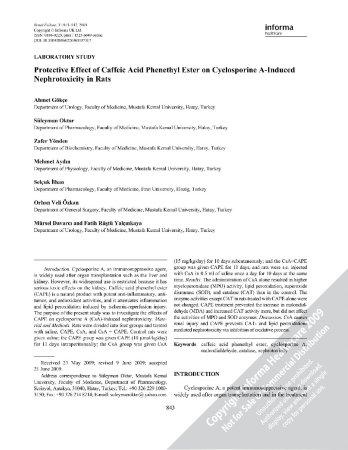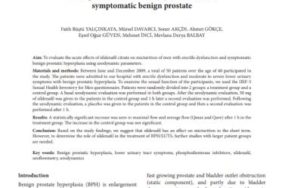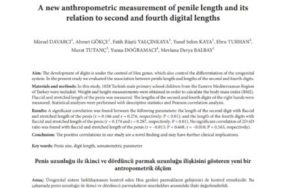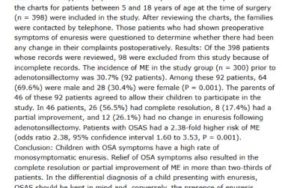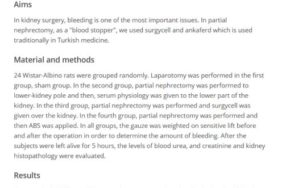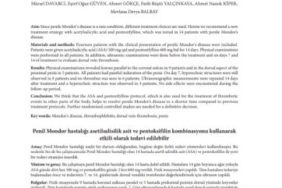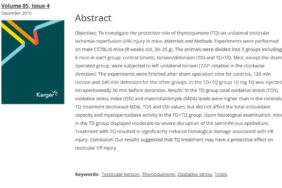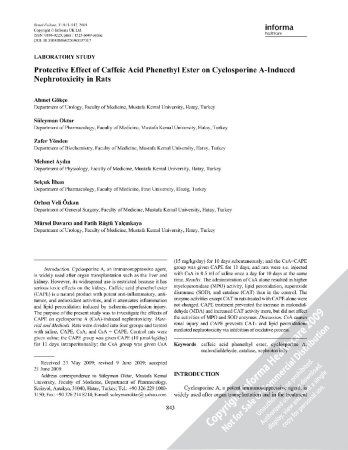
Abstract
Introduction. Cyclosporine A, an immunosuppressive agent, is widely used after organ transplantation such as the liver and kidney. However, its widespread use is restricted because it has serious toxic effects on the kidney. Caffeic acid phenethyl ester (CAPE) is a natural product with potent anti-inflammatory, antitumor, and antioxidant activities, and it attenuates inflammation and lipid peroxidation induced by ischemia-reperfusion injury. The purpose of the present study was to investigate the effects of CAPE on cyclosporine A (CsA)-induced nephrotoxicity. Material and Methods. Rats were divided into four groups and treated with saline, CAPE, CsA, and CsA + CAPE. Control rats were given saline; the CAPE group was given CAPE (10 μmol/kg/day) for 11 days intraperitoneally; the CsA group was given CsA (15 mg/kg/day) for 10 days subcutaneously; and the CsA+CAPE group was given CAPE for 11 days, and rats were s.c. injected with CsA in 0.5 ml of saline evvel a day for 10 days at the same time. Results. The administration of CsA alone resulted in higher myeloperoxidase (MPO) activity, lipid peroxidation, superoxide dismutase (SOD), and catalase (CAT) than in the control. The enzyme activities except CAT in rats treated with CAPE alone were not changed. CAPE treatment prevented the increase in malondialdehyde (MDA) and increased CAT activity more, but did not affect the activities of MPO and SOD enzymes. Discussion. CsA causes renal injury and CAPE prevents CAT- and lipid peroxidation-mediated nephrotoxicity via inhibition of oxidative process.
Keywords:
- caffeic acid phenethyl ester
- cyclosporine A
- malondialdehyde
- catalase
- nephrotoxicity
Previous articleView issue table of contentsNext article
INTRODUCTION
Cyclosporine A, a potent immunosuppressive agent, is widely used after organ transplantation and in the treatment of several autoimmune diseases. However, its toxic effects on kidney have limited a widespread utilization. Nephrotoxicity includes early reversible changes in hemodynamics followed by irreversible injuries characterized by tubular vacuolization, tubular epithelial atrophy, tubulointerstitial fibrosis, cellular desquamations, tubular necrosis, and afferent arteriolopathy.Citation[1,Citation2]Focal segmental thickening and the duplication of glomerular basement membrane were observed in electron microscopic examinations.Citation[3]About 30% of patients treated with CsA develop moderate to severe renal damage, as this is the major dose-limiting side effect of the drug.Citation[4]Although the underlying mechanism of the CsA-induced nephrotoxicity is yet unclear, reactive oxygen species (ROS) have been implicated extensively in the toxicity.Citation[5]In reality, CsA-induced acute and chronic nephrotoxic effects are attenuated by the administration of various types of antioxidants.Citation[6]
Caffeic acid phenyl ester (CAPE), an active component of propolis from honeybee hives, has been used in traditional medicine for decades.Citation[7]It has strong antimicrobial, antiviral, anti-inflammatory, and antineoplastic properties, and has also been shown to decrease the oxidative damage.Citation[8]CAPE completely blocks the production of reactive oxygen species (ROS) in human neutrophils and in the xanthine/xanthine oxidase (XO) system at a concentration of 10 μmol.Citation[9]It has been shown by several workers that CAPE inhibits lipid peroxidation and suppresses oxidative stress.Citation[9–12]Rezzani et al. showed in a previous study that CAPE preserved heart tissue from cyclosporine A-induced cardiac damage.Citation[13]
To the best of our knowledge, the possible protective effects of CAPE on CsA-induced nephrotoxicity have not yet been sufficiently tested. Therefore, the purpose of this study was to investigate the contribution of oxidative stress to CsA-induced nephrotoxicity and the protective role of caffeic acid phenyl ester in a rat model.
MATERIAL AND METHODS
Animals
Wistar-albino female rats, 250–300 g, were used in experiments. All experiments were conducted on University of Firat (Elazig, Turkey). The animals were housed in quiet rooms with a 12 h light/dark cycle (7 a.m. to 7 p.m.) and allowed a commercial standard rat diet and water isim libitum. The experiments were performed in accordance with the Guide for the Deva and Use of Laboratory Animals (DHEW Publication (NIH) 8523, 1985). This study was approved by the Animal Ethical Committee of Sutcuimam University (Kahramanmaras, Turkey).
Experimental Protocols
CsA was solved in saline; CAPE was solved in the ethanol and diluted in saline. The animals were divided into four groups. In the control group (n = 7), rats were given 0.5 ml of olağan saline s.c. daily for a period of 10 days. In the CAPE group (n = 7), rats were treated with CAPE (10 μmol/kg/day) in 0.5 ml of olağan saline i.p. daily for a period of 11 days. Rats in the CsA group (n = 7) were injected with CsA s.c. in 0.5 ml of olağan saline (15 mg/kg) evvel a day for 10 days. Finally, in the CsA + CAPE group (n = 7), rats were treated with CAPE (10 μmol /kg/day) in 0.5 ml of olağan saline i.p. daily for a period of 11 days and were s.c. injected with CsA in 0.5 ml of olağan saline (15 mg/kg) evvel a day for 10 days, beginning from the second day of CAPE administration.
After the last administration of the drug, all rats fasted about 12 hours but had free access to water. Then, the rats were anaesthetized with ketamine + xyslasine (60 mg/kg + 5 mg/kg, i.p.) at the end of the experiment. Blood was collected, and serum was separated and used for various biochemical estimations. The renal tissue was excised immediately from the rats, washed with pre-chilled physical saline, and used for further biochemical estimations. The tissues were homogenized with pre-chilled physical saline in tissue homogenizer, then centrifuged at 3000 g for 10 min at 4ºC, and the supernatant was used for the estimation of various biochemical parameters.
Biochemical Estimations
Renal impairment was assessed by blood urea nitrogen (BUN) and serum creatinine (Cr) levels. The BUN and Cr levels were determined with an autoanalyzer (Olympus AU600, Japan) by using commercial Beckman Coulter diagnostic kits. The protein content in the renal tissue were analyzed in homogenate, supernatant, and extracted samples according to the method of Lowry et al.Citation[14]Lipid peroxidation (as malondialdehyde) levels in renal homogenate were measured with the thiobarbituric acid reaction by the method of Esterbauer and Cheeseman.Citation[15]The values of malondialdehyde (MDA) were expressed as nmol g−1protein. Myeloperoxidase (MPO) activity was determined using a 4-aminoantipyrine/phenol solution as the substrate for MPO-mediated oxidation by H2O2, and changes in absorbance at 510 nm were recorded.Citation[16]One unit of MPO activity was defined as the amount of protein that degrades 1 mol H2O2min−1at 25ºC. Veri were presented as mU g−1protein. Total SOD activity was determined according to the method of Sun et al.Citation[17]The principle of the method is based on inhibition of Nitro Blue Tetrazolium (NBT) reduction by the xanthine-xanthine oxidase system as a superoxide generator. Activity was assessed in the ethanol phase of the lysate after 1.0 ml of ethanol chloroform mixture (5: 3, v/v) was added to the same volume of sample and centrifuged. One unit of superoxide dismutase (SOD) was defined as the amount of enzyme causing 50% inhibition in the NBT reduction rate. The SOD activity was expressed as U mg−1protein. Catalase (CAT) activity was determined according to Aebi’s method.Citation[18]
Chemical Reagents
Superoxide dismutase, malondialdehyde, myeloperoxidase, catalase diagnostic agents, and caffeic acid phenyl ester were bought from Sigma Chemical Co. (St Louis, Missouri, USA). Cyclosporine A was obtained from Novartis (East Hanover, New Jersey, USA).
Statistical Analysis
Data were analyzed by using a commercially available statistics software package (SPSS for Windows v. 12.0, Chicago, Illinois, USA). Distribution of the groups was analyzed with one sample Kolmogrov-Smirnov test. All groups showed olağan distribution, so that parametric statistical methods were used to analyze the veri. One-way ANOVA test was performed and post hoc multiple comparisons were made using least-squares differences. Results are presented as mean ± SEM; p <0.05 was regarded as statistically significant.
RESULTS
The serum levels of BUN and creatine are summarized in Table 1. The levels of BUN and creatine in the CsA group were significantly increased. Serum creatine levels in the CsA+CAPE group were lower than in the CsA group. BUN levels in the CsA+CAPE group were not lower than in the CsA group. The serum levels of BUN and creatine were not different between CAPE and control groups.
DISCUSSION
In the present study, the effect of CAPE was conducted in CsA-induced nephrotoxicity in rats. CsA administration caused renal damage, which was reflected by a significant increase in serum BUN and creatine levels. Increases in these serum enzymes in rats given CsA have been shown in previous studies.Citation[2,Citation19]The levels of BUN and creatine in rats given CAPE alone have not been changed. CAPE treatment prevented the increase in creatine level, but did not affect the increase in BUN level in CsA-induced nephrotoxicity. CAPE treatment does not improve the renal function efficiently because the activities of SOD and MPO enzymes remain high.
The exact mechanism of CsA-induced nephrotoxicity remains obscure, but the underlying mechanism of renal dysfunction has been shown to be associated with oxidative stress.Citation[5]In accordance with previous studies, it was observed that a 15 mg/kg dose of CsA induced lesions in the kidney and significantly altered biochemical parameters and antioxidant enzyme activities in the present studies.Citation[2,Citation5,Citation6]Lipid peroxidation is initiated as a result of ROS-induced abstraction of hydrogen from polyunsaturated fatty acids of cellular membrane, which results in the formation of relatively stable compounds such as MDA.Citation[20]The lipid peroxidation radical results from subsequent interaction with molecular oxygen and hydrogen abstraction from an adjacent lipid hydroperoxide, which are accompanied by cellular degeneration. MPO is a neutrophil and monocyte enzyme that amplifies the reactivity of hydrogen peroxide through the generation of hypochlorous acid, free radicals, and reactive nitrogen species.Citation[21]MPO and its oxidative products play a key role for the enzyme in promotion of lipid peroxidation, protein nitration, and other oxidative modifications.Citation[22]Malondialdehyde is a major lipid peroxidant end product, and our present observations are consistent with the previous findings indicating the increases of lipid peroxidation.Citation[2,Citation23]The neutrophil accumulation and the activation of myeloperoxidase enzyme is probably indirectly responsible for lipid oxidation.Citation[22]Moreover, a correlation has been found between neutrophil and MDA levels.Citation[24]The veri obtained suggest that the accumulation of neutrophils leads to lipid peroxidation. CAPE treatment did not prevent the increase in MPO activity but decreases the MDA levels by preventing the formation of lipid peroxides from fatty acids. Accordingly, CAPE may partly suppress neutrophils infiltration into the injured kidney.
CsA induces the production of free radicals and triggers the accumulation of neutrophil and the activation of MPO. SOD is the first line of defense against the deleterious effects of free oxygen radicals.Citation[25]SOD catalyzes the dismutation of superoxide to H2O2and O2. Further degradation of hydrogen peroxide is catalyzed by the CAT enzyme. SOD enzyme is activated to prevent the increased free radical damage by CsA. As also shown in the present study, SOD and CAT activities were increased after CsA administration in renal tissue. CAPE treatment did not affect the activity SOD enzyme, but increased CAT activity more in rats given CsA. It is likely that SOD activity continues to remain high to remove free radicals from renal tissue because CAPE does not affect directly the activity of SOD enzyme. Tempol, a SOD mimetic agent, prevented CsA-induced renal disfunction.Citation[26]CAPE treatment increased CAT activity in rats given CsA also. There are two possible reasons for this: CAT activity increases to protect the kidney from free radical attack, or CAPE alone may directly increase CAT activity.
In conclusion, we demonstrated an increase in lipid peroxidation and MPO, SOD, and CAT activities in renal tissue of rats given CsA. Additionally, lipid peroxidation-mediated renal injury was prevented partly by CAPE treatment. Our results collectively suggest that CAPE may be an available agent to protect the kidney from CsA-induced damage via inhibition of lipid peroxidation.

